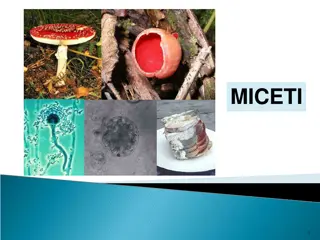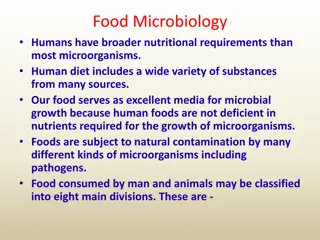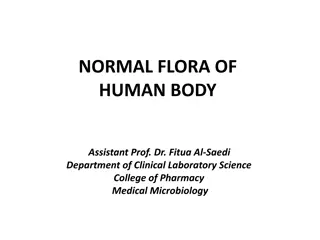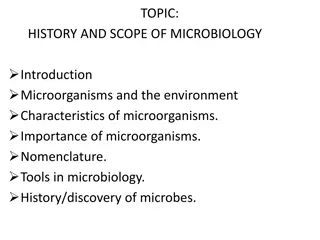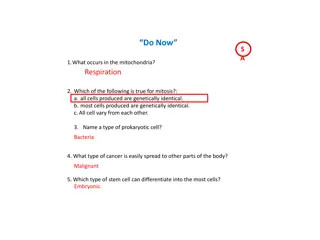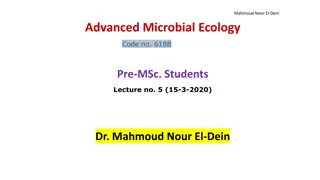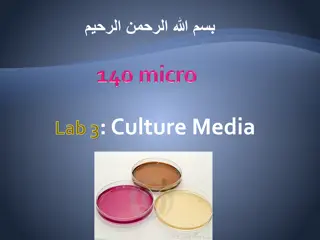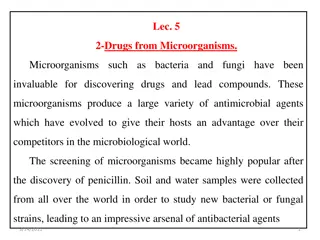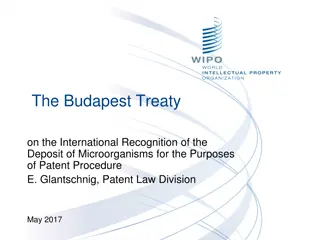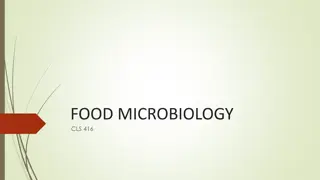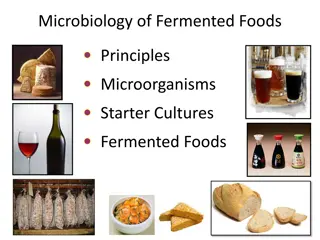
Importance of Microbial Diversity in Agroecosystems
Microorganisms represent a rich repertoire of chemistry and molecular diversity in nature, playing critical roles in ecological processes such as biogeochemical cycles and food chains. Understanding microbial diversity in agroecosystems is vital for ecosystem stability and productivity. Modern agriculture's impact on microbial diversity and the importance of holistic land use planning are discussed in this informative content.
Download Presentation

Please find below an Image/Link to download the presentation.
The content on the website is provided AS IS for your information and personal use only. It may not be sold, licensed, or shared on other websites without obtaining consent from the author. If you encounter any issues during the download, it is possible that the publisher has removed the file from their server.
You are allowed to download the files provided on this website for personal or commercial use, subject to the condition that they are used lawfully. All files are the property of their respective owners.
The content on the website is provided AS IS for your information and personal use only. It may not be sold, licensed, or shared on other websites without obtaining consent from the author.
E N D
Presentation Transcript
Microorganisms represent the richest repertoire in chemistry and molecular diversity in nature, providing the basis for ecological processes such as biogeochemical cycles and food chains, as well as themselves and with superior organisms. maintaining vital relationships among The diversity of microorganisms is as vast as it is unknown. microbial species are known, depending on the habitat studied. So far, between 0.1 and 10% of
In an agroecosystem, the variation in microbial diversity throughout the seasons is still not well understood, since in each season, one microbial community seems to occur more dominantly, accompanied by other less abundant that often are below the level of detection using the current methods of evaluation. The diversity of microorganisms is critical to the functioning of the ecosystem, because there is the need to maintain ecological processes such as decomposition of organic matter, nutrient cycling, pathogens within the ecosystem. soil aggregation and controlling
The functional diversity is very important in ecological assessments of microorganisms within the ecosystem, mainly because little is known about the relationship between the structural and functional diversity of these microorganisms. There is, however, a consensus that microbial diversity is directly related to ecosystem stability.
Modern agriculture is characterized by a constant search for mechanization, pesticide application, coupled with the improvement of plant caused by the intensification of farming did not always receive the necessary attention. The lack of detailed knowledge planning for land use led to a framework of intense environmental degradation, with loss of non-renewable resources and biodiversity. The observation in the increase of degraded agricultural areas has led to a change in the concept of land use, based on a holistic view of the agricultural process, where natural resources (soil, water and biodiversity) are exploited more sustainably. increased crop irrigation, However, yields through chemical the the use of fertilization environmental and genotypes. impact about the ecosystem and/or inadequate
The diversity of microorganisms as an indicator of the quality of agroecosystems has been widely debated, especially in the last decade, with the advent of molecular biology techniques that have favored the evaluation of microorganisms in environmental samples. The main argument in favor of such environmental feature is the fact that the microbial diversity naturally remains unchanged throughout the year. Despite the continued use of land for agricultural practices, the soil may be rich in the biological point of view, since many microorganisms found in this environment are considered important in the biological control of diseases and pests of agriculture. Thus, microbial processes play a fundamental importance in the functioning of production systems, performing tasks directly related to their productivity and sustainability.
Microbiological monitoring of water and soil depends on the quality of water entering the crops. Part of the diversity of Gram- positive bacteria found in rice ecosystems belong to the groups Bacillus, Micrococcus,Staphylococcus, Corynebacterium a nd Lactobacillus, along with a variety of Gram-negative species belonging to the families Enterobacteriaceae, and Peseudomonadaceae Aeromonadaceae, Vibrionaceae, Brucell aceae,Burkholderiaceae, Xanthomonadaceae and others. Among the Gram-negative bacteria, the following species have been identified in rice cultivation waters: Escherichia coli,Enterobacter sp. Citrobacter freundii, Klebsiella pneumoniae, K. oxytoca, Proteus mirabilis, P. vulgaris, P. penneri, Citrobacter spp, Enterobacter cloaceae, Providencia rettgeri, Stenotrophomonas maltophilia,Ochrobactrum anthropi, Chromobacterium violaceum, Yersinia enterocolitica, Pseudomonas aeruginosa, P. fluorescens and Burkolderia cepacia.
The human body is populated by a large number of microorganisms, being distributed in various tissues abundance of microorganisms is greater than the number of cells in the body and is directly related to the immune system and better utilization of feed. alimentary tract associated with organs partially perform digestion, mechanically and chemically. The purpose of the digestive system is the breakdown of food into smaller particles in order to be absorbed in human body. and organs. It is believed that the The digestive system consists of the that
The gastrointestinal tract of mammals maintains a highly diverse microbial population that plays an important role in nutrition metabolism, protection against pathogens, and the development of the immune system. It is estimated that at least 1000 different bacterial species coexist the human intestinal tract. Although often considered as pathogens, the majority of microorganisms in intestinal tract have beneficial effects. They play multiple roles in the human host, as they are directly involved in the synthesis of vitamins and cofactors, help to degrade complex lipids and polysaccharides and also have detoxifying action. It is known that bacteria intensely populate the most part of the enteric tract. However, the stomach and the small intestine have fewer microorganisms due to the presence of hydrochloric acid. The large Lactobacillus sp., Escherichia coli, Klebsiella sp. And Proteus sp. that assist in the synthesis of degradation of the food. intestine has numerous bacteria, especially
The intestinal microbiota is a dynamic mixture of microorganisms, whose composition varies along the gastrointestinal tract (GIT) and between the mucosa and the intestinal lumen. The microbiota develops all the time, due to the interaction of genetic factors, contact with the environment, diet and disease, thus explaining the fact that each individual presents a unique microbiota.The genotype of the individual may also be a factor that influences the bacterial community in the gut, following a hypothesis that in the gut there are sites of specific adhesion to some bacteria in the host, selecting the most important. These predetermined. adhesion sites are probably genetically
Fig 1. Factors Fig 1. Factors influencing the bacterial community in the human gut. influencing the bacterial community in the human gut.
The highest concentration of microorganisms and metabolic activity is found in the large intestine. Starting from the ileum the concentration of bacteria increases gradually, reaching 10 to 10 CFU/g in the colon. The adult and stable microbiota are composed of autochthonous species (permanent members) and allochthonous (transient members that are acquired from an external source). The microbiota are diverse, comprising 400-1000 species, of which over 60% are not cultivable outside the intestine. The intestinal microbiota plays different roles that are important for the host such as they exert a trophic effect on the intestinal epithelium, favoring the development of microvilli, which in turn promotes the absorption of the nutrients. The diet is a major determinant for the persistence of certain bacteria in the gastrointestinal tract, because the diet provides nutrients, not only for the host, but also for bacteria that are in it. Components from indigestible food serve as carbon and energy source for the human gut bacteria.
The intestinal biota is increasingly considered a symbiotic partner for the maintenance of health. Over the years, the intestinal microbiota has become recognized in the development of the immune system. The cells of the intestinal mucosa and microbiota (enterocyctes, dendritic cells, lymphocytes, macrophages) regulate the production of several cytokines and chemokines). The homeostasis of the intestinal tract is dependent on characteristics of the host (age, gender, genetics, etc) and environmental conditions (stress, drugs, gastrointestinal surgery, infectious and toxic agents). Changes in the gut microorganisms can be reversed by diet and weight loss. Qualitative and quantitative changes in the consumption of specific food components (fatty acids, carbohydrates, micronutrients) have effects not only on the composition of intestinal microbiota, but can modulate the expression of genes in the host tissues such as the liver, adipose tissue, intestine, and muscle. This in turn can lead to the development or decrease of fat mass and metabolic disorders associated with the intestinal barrier and systemic immunity. These intestinal microbiota are composed of various bacterial groups. Therefore, it is essential to keep them balanced to preserve human health.
Some bacteria have been used as a probiotic, such as species of the genera Lactobacillus and Bifidobacterium, which help in the restoration of the human intestinal microbiota, when the intestinal biota is drastically reduced and is vulnerable to attack by the pathogens
The members of the normal microbiota can cause diseases under certain circumstances. Since they have a non-invasive way of life defined by limitations of the medium, unless they are held they can become pathogenic. Population levels of microorganisms are determined multifactorial processes.The bacteria of the intestinal tract colonization of the intestinal tract depends on the ability of bacterial adhesion. There are bacteria on the adhesion sites on the intestinal mucosa, which need not to be periodically reintroduced. However, there is the native biota that is external to the gut ecosystem, thus is transient. by the exogenous and endogenous have heterogeneous distribution. The
The microbiota has the following functions: antibacterial, immunomodulatory and metabolic. Antibacterial prevents the Immunomodulatory activity helps the immune system and metabolic function contributes to facilitate the nutrition. It is important to highlight the impact that pathogenic bacteria can cause in the public health issue, resulting serious intestinal diseases such as diarrhea - considered as the most common disease caused by viruses and bacteria and one of the diseases that affects large no of children in the world. Hence, it is important to know the bacteria that may possibly compromise the gut and the human organism as a whole. The use of antibiotics in the rats can increase intestinal microbiota associating to some changes compounds in the diet and how it is spent and stored. establishment of pathogenic bacteria. that affect the acquisition of energy from
Salmonella serogroups and 2000 serotypes and may be classified as typhoid and non-typhoid. This genre is usually associated with food. Salmonella enteritidis is one of the serotypes most widely distributed in the world and one of the major contaminants in food, usually beef, pork, poultry and eggs. This bacterium usually causes fever, abdominal cramps and diarrhea, which can present blood clots. A study by the Center for Epidemiological Surveillance - SES / SP showed that from 1999 to 2007,S. enteritidis was responsible for 42.3% of outbreaks of diarrhea, showing the attention in public health that this bacterium should be given. is represented by more than 40
Escherichia coli (EPEC) causes gastroenteritis in almost all age groups. It is similar penetrates directly into the intestinal epithelium where it can multiply, causing dysentery. It can be transmitted by the consumption of water and many foods such as milk and milk products. The importance of EPEC as a cause of diarrhea has declined since the 1960s, but is the primary infectious including South America, Africa and Asia. EPEC outbreaks are sporadic, emerging in places where sanitary conditions are poor. Other bacteria that are not involved directly with the human gut, but are cause of worry in the matter of public health, are related to urogenital infections, such as Proteus vulgaris, which inhabits the human gut, but causes urinary tract infections and other complications. to Shigella sp because it agent in children in developing countries,
Having a prebiotic diet can help treating the intestine infections, such as those caused by the bacteria of the genus Salmonella because these prebiotic molecules serve as substrate for the growth of bacteria, which has the potential to eradicate other pathogenic bacteria such as Lactobacillus. Microbial diseases of the large intestine are second only to the respiratory system diseases. Pathogens are able to cross the digestive system and extend to organs, causing rotavirus. Bacillus cereus is common in the soils and vegetables. Rice has vast abundance of this bacterium. It is generally harmless, but when found in the foods, can cause illnesses such as gastroenteritis. The rice, for being a plant that is cultivated in water, has the risk of receiving numerous microorganisms. Water is characterized by low nutrients. Therefore, bacteria tend to grow on standing surfaces in particular materials, as is the case with rice. Therefore, paddy fields are important for local biodiversity conservation because they support a rich biodiversity and high productivity feature. Rice is one of the most important cereal crops in the world. Therefore, the conservation of biodiversity in agriculture is a challenge of great importance. Several studies have demonstrated the contribution of ecosystems such as rice, providing habitats for creation of numerous microorganisms. numerous diseases, e.g., gastroenteritis caused bySalmonella and
The microorganisms in the biosphere perform important functions, for example, the influence on biogeochemical processes. In aquatic environments, there is an important chain of interactions that affect the elements involved in the environment.


